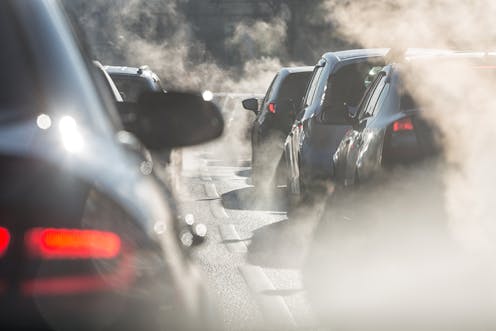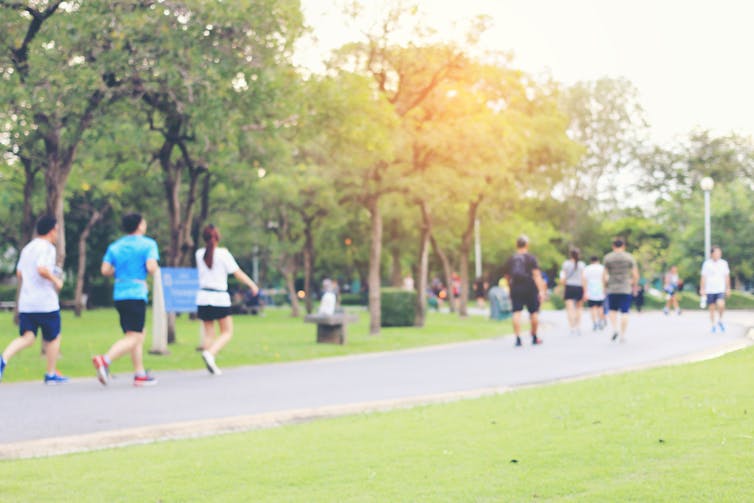Walking mightn't be good for you if it's through Australia's polluted city streets
- Written by Lidia Morawska, Professor, Science and Engineering Faculty; Director, International Laboratory for Air Quality and Health (WHO CC for Air Quality and Health); Director - Australia, Australia – China Centre for Air Quality Science and Management (ACC-AQSM)
 If you're taking a walk, go to the park instead of walking near cars. from www.shutterstock.com
If you're taking a walk, go to the park instead of walking near cars. from www.shutterstock.comWe don’t see air pollution, unless its concentration is high, and so we don’t realise it’s there and that we breathe it in. We don’t think of the devices we use every day and many times a day: cars, as air pollution sources.
A study conducted in London in people over 60 showed as short a period as two hours walking along the busy Oxford Street could be detrimental to health. The ones who experienced the effects were not only the participants who already suffered from a medical condition (ischaemic heart disease and chronic obstructive pulmonary disease), but also perfectly healthy participants, who constituted the so called “control group” for the study.
Walking is good for us, and has well-established health benefits. But the London study showed the beneficial effects are reduced by the detrimental effects of inhaling polluted air, with effects mainly including reduced function of the lungs.
Read more - Australia’s dirty secret: who’s breathing toxic air?
So what about in Australia?
Some may argue this study isn’t relevant to Australia because our cities are cleaner. This is true when considering air pollution concentrations measured away from pollution sources, the way it’s typically done for regulatory purposes. But the concentrations are much higher in direct proximity to the sources, which is the case on busy streets, where cars are next to the pedestrians.
One of the key pollutants emitted by cars is ultrafine particles (defined in the London study as those in the range from 10 to 300 nanometres). The median value of their concentrations on Oxford Street was around 25,000 particles/cm3, which is not very different to the frequently measured concentrations reported in Brisbane.
Apart from Brisbane where extensive monitoring of ultrafine particles has been conducted over the past two decades, there is next to no information about the concentrations of these particles available for other Australian cities, as there has been no monitoring conducted. But we can assume the concentrations would be somewhat similar in Brisbane and other cities.
So people walking along busy streets of Australian cities would likely experience very similar detrimental effects to the effects experienced by the participants of the London study.
Read more: Transport access is good for new housing, but beware the pollution
 Exercise in an area free from pollution.from www.shutterstock.com
Exercise in an area free from pollution.from www.shutterstock.comWho is affected?
Younger readers, in their thirties or forties may say only older, more frail and susceptible people are affected. But this isn’t the case: air pollution affects everybody, and studies have shown impacts of air pollution on younger people as well.
Of particular concern are the impacts on children. If you’re planning to take your baby or toddler on a stroll in a pram along busy roads, they may be exposed to high pollution levels, elevating their risk of asthma, pneumonia and reduced lung function.
So what should we do?
This doesn’t mean we should stop exercising outdoors. But it does mean we should make an effort to avoid places that put us in proximity to air pollution sources while we exercise. Go for a walk or a stroll in a park, not on a busy street. If you visit heavily polluted cities around the world, go to a gym, but not for a jog in heavy haze.
Read more: Why coal-fired power stations need to shut on health grounds
Ultimately we shouldn’t have to change our lifestyle, we should aim to reduce pollution.
The transition to clean energy is happening before our eyes, but in some places faster than in others. For example Norway has the largest per capita fleet of plug-in electric cars. And China has just announced the creation of the world’s largest floating solar power plant.
Making the transition faster will ensure the generations of people living now will experience the benefits of clean air.
Lidia Morawska does not work for, consult, own shares in or receive funding from any company or organization that would benefit from this article, and has disclosed no relevant affiliations beyond their academic appointment.
Authors: Lidia Morawska, Professor, Science and Engineering Faculty; Director, International Laboratory for Air Quality and Health (WHO CC for Air Quality and Health); Director - Australia, Australia – China Centre for Air Quality Science and Management (ACC-AQSM), Queensland University of Technology





